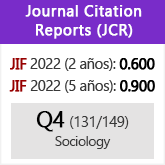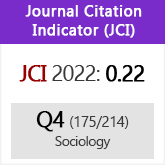Redes y mecanismos de interdependencia. Desarrollos teóricos más allá de los modelos de acción racional
DOI:
https://doi.org/10.3989/ris.2008.01.14Palabras clave:
Acción colectiva, Cascadas, Influencia Social, Internet, UmbralesResumen
Existe interdependencia cuando las acciones de unos individuos influyen en las decisiones (y posteriores acciones) de otros individuos. Este artículo sostiene que las redes sociales definen la estructura de ese espacio de influencia y desatan una serie de mecanismos de los que la teoría de la elección racional no puede dar cuenta. Las redes sociales abren acceso a las ideas y acciones de otros individuos, y esta exposición determina la satisfacción de umbrales, el tempo con en el que se llevan a cabo las acciones y la emergencia de procesos de contagio, cascadas de información y epidemias. Este artículo defiende que la teoría de la elección racional no ofrece las herramientas necesarias para modelizar tales procesos si no se inserta en una teoría general de redes. Éste es especialmente el caso en unos momentos en los que la interdependencia de individuos está adquiriendo, al amparo de las nuevas tecnologías, mayor relevancia empírica.
Descargas
Citas
Aguiar, F. (1990), “La lógica de la cooperación”, Zona Abierta 54-55:7-41.
Axelrod, R. (1984), The Evolution of Cooperation. New York: Basic Books.
Barabási, A.L. (2002), Linked. The New Science of Networks. Cambridge, MA: Perseus.
Bennett, W.L. (2003), “Communicating Global Activism: Strengths and Vulnerabilities of Networked Politics.” Information, Communication & Society 6:143-168. doi:10.1080/1369118032000093860
Biggs, M. (2005), “Strikes as Forest Fires: Chicago and Paris in the late nineteenth century”, American Journal of Sociology, 110:1684-1714. doi:10.1086/427675
Bob, C. (2005), The Marketing of Rebellion. Insurgents, Media, and International Activism Cambridge: Cambridge University Press.
Buchanan, M. (2003), Small World: Uncovering Nature’s Hidden Networks. London: Phoenix.
Burt, R.S. (1987), “Social Contagion and Innovation: Cohesion versus Structural Equivalence.” American Journal of Sociology 92:1287-1335. doi:10.1086/228667
Burt, R.S. (1992), Structural Holes. The Social Structure of Competition. Cambridge, MA: Harvard University Press.
Burt, R.S. (2005), Brokerage and Closure. An Introduction to Social Capital. Oxford: Oxford University Press.
Castells, M. (ed.) (2004a), The Network Society. A cross-cultural perspective. Cheltenham: Edward Elgar.
Castells, M. (2004b), The Power of Identity. Oxford: Blackwell.
Castells, M. (2009), Communication Power. Oxford: Oxford University Press.
Castells, M., M. Fernandez-Ardevol, J. Linchuan-Qiu and A. Sey (2006), “Electronic communication and socio-political mobilisation: a new form of civil society”, Global Civil Society 2005/6, edited by Marlies Glasius, Mary Kaldor, and Helmut Anheier. London: Sage Publications.
Cleaver, H.M. (1998), “The Zapatista Effect: the Internet and the Rise of an Alternative Political Fabric.” Journal of International Affairs 51:621-40.
Coleman, J.S. (1988), “Social Capital in the Creation of Human Capital”, American Journal of Sociology 94:S95-S120. doi:10.1086/228943
Coleman, J.S. (1990), Foundations of Social Theory. Cambridge, Mass.: Belknap Press of Harvard University Press.
Coleman, J.S., H. Menzel and E. Katz (1957), ”The diffusion of an innovation among physicians”, Sociometry, 20:253-270. doi:10.2307/2785979
Chadwick, A. 2006. Internet Politics. States, Citizens, and New Communication Technologies. New York: Oxford University Press.
Chambat, P. (2000), “Computer-Aided Democracy: The Effects of Information and Communication Technologies on Democracy.” in The Information Society in Europe. Work and Life in an Age of Globalization, edited by Ken Ducatel, Juliet Webster, and Werner Herrmann. Oxford: Rowman & Littlefield.
Diani, M. (2003), “Networks and Social Movements: a Research Programme”, in Social Movements and Networks. Relational Approaches to Collective Action, edited by Mario Diani and Doug McAdam. New York: Oxford University Press.
Elster, J. (1989), The Cement of Society. Cambridge: CUP, Cambridge University Press.
Flap, H., and Ed. Boxman (2001), “Getting Started: the Influence of Social Capital on the Start of the Occupational Career.” in Social Capital. Theory and Research, edited by Nan Lin, Karen Cook, and Ronald S. Burt. New York: Aldine de Gruyter.
Gilbert, N.l and K. Troitzsch (2005), Simulation for the Social Scientist. Maidenhead: Open University Press.
Gladwell, M. (2001), The Tipping Point. How little things can make a big difference. London: Abacus.
Goyal, S. (2007), Connections. An Introduction to the Economics of Networks. Princeton, NJ: Princeton University Press.
Granovetter, M. (1973), “The strength of weak ties”, American Journal of Sociology 78:1360-1380. doi:10.1086/225469
Granovetter, M. (1978), “Threshold Models of Diffusion and Collective Behaviour”, Journal of Mathematical Sociology 9:165-179.
Granovetter, M. (1995), Getting a Job: A Study of Contacts and Careers, 2nd Edition. Chicago, IL: University of Chicago Press.
Hajnal, P.I. (ed.) (2002), Civil Society in the Information Age. Aldershot: Ashgate.
Hardin, R. (1982), Collective Action. Baltimore, Maryland: John Hopkins University Press.
Hedström, P. (1994), “Contagious collectivities: on the spatial diffusion of Swedish trade unions, 1890-1940.” American Journal of Sociology 99:1157-79. doi:10.1086/230408
Klein, N. (2002), “The vision thing: were the DC and Seattle protests unfocused, or are critics missing the point?” in From Act Up to the WTO: Urban Protest and Community Building in the Era of Globalization edited by Benjamin Shepard and Ronald Hayduk. New York: Verso.
Klotz, R.J. (2004), The Politics of Internet Communication. Lanham: Rowman & Littlefield.
Knoke, D. (1990), Political Networks. The Structural Perspective. New York: Cambridge University Press.
Kolko, B.E. (ed.) (2003), Virtual Publics. Policy and Community in an Electronic Age. New York: Columbia University Press.
Lewis, K., J. Kaufman, M. Gonzalez, A. Wimmer and N.A. Christakis (2009), “Tastes, Ties, and Time: A New (Cultural, Multiplex, and Longitudinal) Social Network Dataset Using Facebook.com” Social Networks, 30: 330-342. doi:10.1016/j.socnet.2008.07.002
Lin, N., K. Cook and R.S. Burt (eds.) (2001), Social Capital: Theory and Research. New York, NY: Aldine de Gruyter.
Lin, N. and M. Dumin (1986), “Access to Occupations Through Social Ties”, Social Networks 8:365-385. doi:10.1016/0378-8733(86)90003-1
Linares, F. (2004), “Hawks, Zealots and Hypocrites but not Free Riders: the logics of cooperation in Llano del Beal.” Rationality and Society 16:437-476. doi:10.1177/1043463104044683
Lohmann, S. (1994), “Dynamics of Informational Cascades: the Monday Demonstrations in Leipzig, East Germany, 1989-1991.” World Politics 47:42-101. doi:10.2307/2950679
Marwell, G. and P. Oliver (1993), The Critical Mass in Collective Action. Cambridge: Cambridge University Press.
Marwell, G. and R. Prahl (1988), “Social networks and collective action. A theory of critical mass III.” American Journal of Sociology 94:502-34. doi:10.1086/229028
Milgram, S. (1967), “The Small World problem.” Psychology Today 2:60-67.
Miller, L.M. (2007), «Coordinación y Acción Colectiva.» Revista Internacional de Sociología 46:161-183. doi:10.3989/ris.2007.i46.8
Myers, D.J. (2000), «The Diffusion of Collective Violence: infectiousness, susceptibility, and mass media networks.» American Journal of Sociology 106:173-208. doi:10.1086/303110
Norris, P. (2001), Digital Divide: Civic Engagement, Information Poverty, and the Internet Worldwide. Cambridge: Cambridge University Press.
Oliver, P. and G. Marwell (1988), “The paradox of group size in collective action: a theory of critical mass II.” American Sociological Review 53:1-8. doi:10.2307/2095728
Oliver, P., G. Marwell and R. Teixeir (1985), “A theory of the critical mass. I. Interdependence, group heterogeneity, and the production of collective action”, American Journal of Sociology 91:522-56. doi:10.1086/228313
Olson, M. (1965), The Logic of Collective Action: public goods and the theory of groups. Cambridge, MA: Harvard University Press.
Passy, F. (2003), “Social Networks Matter. But How?”, Social Movements and Networks. Relational Approaches to Collective Action, edited by Mario Diani and Doug McAdam. New York: Oxford University Press.
Paxton, P. (1999), “Is Social Capital Declining in the United States? A Multiple Indicator Assessment.” American Journal of Sociology 105:88-127. doi:10.1086/210268
Paxton, P. (2002), “Social Capital and Democracy: an Interdependent Relationship”, American Sociological Review 67:254-277. doi:10.2307/3088895
Putnam, R.D. 1995. “Bowling Alone: America’s Declining Social Capital.” Journal of Democracy 6:65-78. doi:10.1353/jod.1995.0002
Putnam, R.D. (2000), Bowling Alone. The collapse and revival of American community. New York, NY: Simon and Schuster.
Shepard, B. and R. Hayduk (2002), From Act Up to the WTO. Urban protests and community building in the era of globalization. New York: Verso.
Simmel, G. [1908] 1955, “The web of group affiliations.” in Conflict. The web of group affiliations. New York: Free Press.
Sunstein, C. (2001), Republic.com. Princeton, NJ: Princeton University Press.
Ullmann-Margalit, E. (1977), The Emergence of Norms. Oxford: Oxford University Press.
Valente, Th.W. (1996), “Social network thresholds in the diffusion of innovations”, Social Networks 18:69-89. doi:10.1016/0378-8733(95)00256-1
van den Bulte, Ch. and G.L. Lilien (2001), “Medical Innovation Revisited: Social Contagion versus Marketing Effort”, American Journal of Sociology, 106:1409-35. doi:10.1086/320819
Watts, D.J. (1999), “Networks, Dynamics and the Small World Phenomenon”, American Journal of Sociology, 105: 493-527. doi:10.1086/210318
Watts, D.J. (1999), Small Worlds. The Dynamics of Networks between Order and Randomness. Princeton, NJ: Princeton University Press.
Watts, D.J. (2003), Six Degrees. The Science of a Connected Age. London: William Heinemann.
Watts, D.J. (2007), “A twenty-first century science”, Nature, 445: 489. doi:10.1038/445489a PMid:17268455
Watts, D.J. and S.H. Strogatz (1998), “Collective dynamics of ‘small world’ networks”, Nature, 393:440-442. doi:10.1038/30918 PMid:9623998
Descargas
Publicado
Cómo citar
Número
Sección
Licencia
Derechos de autor 2009 Consejo Superior de Investigaciones Científicas (CSIC)

Esta obra está bajo una licencia internacional Creative Commons Atribución 4.0.
© CSIC. Los originales publicados en las ediciones impresa y electrónica de esta Revista son propiedad del Consejo Superior de Investigaciones Científicas, siendo necesario citar la procedencia en cualquier reproducción parcial o total.Salvo indicación contraria, todos los contenidos de la edición electrónica se distribuyen bajo una licencia de uso y distribución “Creative Commons Reconocimiento 4.0 Internacional ” (CC BY 4.0). Puede consultar desde aquí la versión informativa y el texto legal de la licencia. Esta circunstancia ha de hacerse constar expresamente de esta forma cuando sea necesario.
No se autoriza el depósito en repositorios, páginas web personales o similares de cualquier otra versión distinta a la publicada por el editor.

















